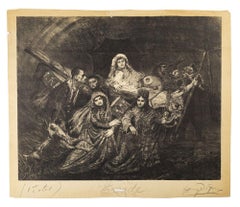Henry de Groux Art
1867-1930
Henry de Groux was a Belgian Symbolist painter, sculptor and lithographer. As a Symbolist, he used the traditions of religious painting in his way, interpreting the plots and relating them to modernity. Groux's 1889 painting Christ aux Outrages, widely described as his masterwork, depicted Jesus being attacked by a mob. Later in life, he produced many works depicting the horrors of the First World War.
to
5
1
5
5
5
1
1
Les Aveugles ( The Blind )
By Henry de Groux
Located in Paonia, CO
Henri DeGroux (1866-1930) was a Belgian Symbolist painter, sculptor and lithographer. He was known for his allegorical, religious and historical subject matter. He became an inspired...
Category
1910s Symbolist Henry de Groux Art
Materials
Lithograph
En Route - Original Lithograph by Henry de Groux - 1866
By Henry de Groux
Located in Roma, IT
En Route is an original lithograph on paper realized by Henry de Groux.
Hand-signed by the artist on the lower right margin.
Good conditions except fo...
Category
Late 19th Century Henry de Groux Art
Materials
Lithograph
Les Drapeaux ( The Flags )
By Henry de Groux
Located in Paonia, CO
Henri DeGroux (1866-1930) was a Belgian Symbolist painter, sculptor and lithographer. He was known for his allegorical, religious and historical subject matter. He became an inspired...
Category
1910s Symbolist Henry de Groux Art
Materials
Lithograph
Prisonnier Au Repos (Prisoner At Rest) by Henri DeGroux
By Henry de Groux
Located in Paonia, CO
Henri DeGroux (1866-1930) was a Belgian Symbolist painter, sculptor and lithographer. He was known for his allegorical, religious and historical subject matter. He became an inspired...
Category
1910s Symbolist Henry de Groux Art
Materials
Lithograph
Physionomie Du Front (Front View)
By Henry de Groux
Located in Paonia, CO
Henri DeGroux (1866-1930) was a Belgian Symbolist painter, sculptor and lithographer. He was known for his allegorical, religious and historical subject matter. He became an inspired...
Category
1910s Symbolist Henry de Groux Art
Materials
Lithograph
Ambulkance
By Henry de Groux
Located in Paonia, CO
Henri DeGroux (1866-1930) was a Belgian Symbolist painter, sculptor and lithographer. He was known for his allegorical, religious and historical subject matter. He became an inspired...
Category
1910s Symbolist Henry de Groux Art
Materials
Lithograph
Related Items
Hand of Africa - Mandela, Former South African President, Signed Artwork, Hand
By Nelson Mandela
Located in Knowle Lane, Cranleigh
Nelson Mandela, Hand of Africa, Signed Limited Edition Lithograph
Many people are unaware that Nelson Mandela turned his hand to art in his 80's as a way of leaving a legacy for his ...
Category
Early 2000s Contemporary Henry de Groux Art
Materials
Lithograph
Le Fondeur Paris [Steel Worker]
By Eugène Carrière
Located in New York, NY
Carriere, Eugene. Le Fondeur, Paris 1900 [Steel Worker], Color lithograph.
Ref: Das Fruhe Plakat 134. 51 x 34 3/4 inches.
Eugène Anatole Ca...
Category
Early 1900s Symbolist Henry de Groux Art
Materials
Lithograph
Abel Pann Israeli Bezalel School Lithograph Judaica Biblical Print Jewish Art
By Abel Pann
Located in Surfside, FL
Abel Pann (1883–1963) was a European Jewish painter who settled in the Talpiot neighborhood of Jerusalem in the early twentieth century and taught at the Bezalel Academy of Art under Boris Schatz.
Abba Pfeffermann (later Abel Pann), born in Latvia or in Kreskowka, Vitebsk, Belarus, was a European Russian Jewish art...
Category
Mid-20th Century Symbolist Henry de Groux Art
Materials
Lithograph
Abel Pann Israeli Bezalel School Lithograph Judaica Biblical Print Jewish Art
By Abel Pann
Located in Surfside, FL
Abel Pann (1883–1963) was a European Jewish painter who settled in the Talpiot neighborhood of Jerusalem in the early twentieth century and taught at the Bezalel Academy of Art under...
Category
Mid-20th Century Symbolist Henry de Groux Art
Materials
Lithograph
"Quinquina Dubonnet" Original Jules Cheret Maitre de l'Affiche
By Jules Chéret
Located in Hinsdale, IL
CHERET, JULES
(1836 - 1932)
"Quinquina Dubonnet"
Original lithograph from “Les Maitres de L’Affiche” series
Printed by Imprimerie Chaix, Paris
Bearing MDL stamp lower right, from issue #28, 1898. Plate #109
Unframed Size: 11 3/8 x 15 3/4”
The “Les Maitres de l’Affiche” series was offered as a subscription series to collectors every month for 60 months, from December 1895 through November 1900. The “Maitres de l’Affiche,” were issued as separate numbered sheets, referred to as “plates”. They were numbered, with the printers name “Imprimerie Chaix,” in the margin at the bottom left hand corner, “PL.1” to “PL.240.” In the margin at the bottom right hand corner of each, is a blind
embossed stamp from a design of Cheret’s. The smaller format and the fact the “Maitres” were a paid subscription series, allowed Imprimerie Chaix to use the latest state of the art printing techniques, not normally used in the large format posters due to cost. A very high quality of paper was used, where as the large format posters were printed on lesser quality newsprint, due to cost and a short expected life span. This explains why the quality of the printing, in the “Maitres de l’Affiche,” usually far exceeds that of their larger counterparts.
“The Dubonnet poster...
Category
1890s Art Nouveau Henry de Groux Art
Materials
Lithograph
H 17.5 in W 14.5 in D 0.5 in
Abel Pann Israeli Bezalel School Lithograph Judaica Biblical Print Jewish Art
By Abel Pann
Located in Surfside, FL
Abel Pann (1883–1963) was a European Jewish painter who settled in the Talpiot neighborhood of Jerusalem in the early twentieth century and taught at the Bezalel Academy of Art under Boris Schatz.
Abba Pfeffermann (later Abel Pann), born in Latvia or in Kreskowka, Vitebsk, Belarus, was a European Russian Jewish artist who immigrated to Ottoman Palestine and settled in Jerusalem. He was married to Esther Nussbaum. Pann's youngest son was killed in the 1947–1949 Palestine war. After that loss, he turned to painting scenes of the Holocaust. He died in Jerusalem in 1963.
Pann studied the fundamentals of drawing for three months with the painter Yehuda Pen of Vitebsk, who also taught Marc Chagall. In his youth, he traveled in Russia and Poland, earning a living mainly as an apprentice in sign workshops. In 1898 he went south to Odessa, where he was accepted into the Academy of Fine Arts. In 1903, he was in Kishinev, where he documented the Kishinev pogrom with drawings; an effort that is thought to have contributed to his self-definition as an artist who chronicles Jewish history. Still in 1903, he moved to Paris, where he rented rooms in La Ruche, a Parisian building (which still exists) where Modigliani, Chagall, Chaim Soutine and other Jewish artists also lived. Pann studied at the French Academy under William-Adolphe Bouguereau. He earned his living primarily by drawing pictures for the popular illustrated newspapers of the era. In 1912, Boris Schatz, founder and director of the Bezalel Academy of Arts and Design visited Pann in Paris and invited him to come work in Jerusalem.
In 1913, after traveling in Southern Europe and Egypt, Pann arrived in Jerusalem, where he had decided to settle for life. Pann went to see Schatz and it was decided that he would head the painting department at the Bezalel Academy for several months while Schatz embarked on an extensive overseas fund-raising trip. According to Haaretz art critic Smadar Sheffi, a work form this period with the simple title "Jerusalem" shows a cluster of buildings at sunset "with a sky in blazing orange." The painting is "more expressive and abstract that is typical of his work," and Sheffi speculates that "the encounter with the city" of Jerusalem was a "strong emotional experience" for the artist. Pann returned to Europe to arrange his affairs before moving permanently to the British Mandate of Palestine, but was caught on the continent by World War I. Pann's wartime paintings would prove to be among "the most important" of his career. He made many posters to support the French war effort. He also made a series of fifty drawings showing the extreme suffering of Jewish communities caught in the fighting between Germany, Poland and Russia. Art critic Smadar Sheffi regards them as "the most important part of his oeuvre." These "shocking" drawings put modern viewers in mind of depictions of the Holocaust. Pann's drawings were intended as journalistic documentation of the fighting and were successfully exhibited in the United States during the War. According to Pann's autobiography, the Russians, who were allied with the French, refused to allow a wartime exhibition of the drawings in France. According to The New York Times, the drawings were published in Paris during the war, but the government intervened to block their distribution on the grounds that they "reflected damagingly upon an ally" (Russia).
Upon his return to Jerusalem in 1920, Pann took up a teaching position at the Bezalel Academy and wrote that he was about to embark on his life-work, the painting and drawing of scenes from the Hebrew Bible. He returned briefly to Vienna, where he met and married Esther Nussbaum and purchased a lithographic press, which the couple brought home to Jerusalem. Pann began work on a series of lithographs intended to be published in an enormous illustrated Bible, and although that series was never completed, he is widely admired for the series of pastels inspired by Bible stories that he began in the 1940s. The iconography of these works is linked to the 19th century orientalism. He was part of a movement of contemporary Jewish artists interested in Biblical scenes, including Ephraim Moses Lilien...
Category
Mid-20th Century Symbolist Henry de Groux Art
Materials
Lithograph
Abel Pann Israeli Bezalel School Lithograph Judaica Biblical Print Jewish Art
By Abel Pann
Located in Surfside, FL
Abel Pann (1883–1963) was a European Jewish painter who settled in the Talpiot neighborhood of Jerusalem in the early twentieth century and taught at the Bezalel Academy of Art under...
Category
Mid-20th Century Symbolist Henry de Groux Art
Materials
Lithograph
Starry Night - Limited Edition, Figurative, Contemporary, Star, Night, Child
By Charlie Mackesy
Located in Knowle Lane, Cranleigh
Starry Night is a lithograph based on a watercolour by Charlie Mackesy. The edition is limited to 150 and each piece has been signed by Charlie Mackesy...
Category
2010s Other Art Style Henry de Groux Art
Materials
Lithograph
H 11.82 in W 7.88 in D 0.4 in
Abel Pann Israeli Bezalel School Lithograph Judaica Biblical Print Jewish Art
By Abel Pann
Located in Surfside, FL
Abel Pann (1883–1963) was a European Jewish painter who settled in the Talpiot neighborhood of Jerusalem in the early twentieth century and taught at the Bezalel Academy of Art under...
Category
Mid-20th Century Symbolist Henry de Groux Art
Materials
Lithograph
Abel Pann Israeli Bezalel School Lithograph Judaica Biblical Print Jewish Art
By Abel Pann
Located in Surfside, FL
Abel Pann (1883–1963) was a European Jewish painter who settled in the Talpiot neighborhood of Jerusalem in the early twentieth century and taught at the Bezalel Academy of Art under...
Category
Mid-20th Century Symbolist Henry de Groux Art
Materials
Lithograph
"Grande Tuilerie d’Ivry" from Les Maitres de l'Affiche
By Alexandre Charpentier
Located in Hinsdale, IL
CHARPENTIER, ALEX
(1856 -1909)
"Grande Tuilerie d’Ivry"
Original lithograph from "Les Maitres de L'Affiche" series
Printed by Imprimerie Chaix, Paris
Bearing MDL stamp lower right, issue # 33, 1898. Plate #131
Unframed Size: 11 3/8 x 15 3/4”The
"Les Maitres de l'Affiche" series was offered as a subscription series to collectors every month for 60 months, from December 1895 through November 1900. The "Maitres de l'Affiche," were issued as separate numbered sheets, referred to as "plates". They were numbered, with the printers name "Imprimerie Chaix," in the margin at the bottom left hand corner, "PL.1" to "PL.240." In the margin at the bottom right hand corner of each, is a blind embossed stamp from a design of Cheret's. The smaller format and the fact the "Maitres" were a paid subscription series, allowed Imprimerie Chaix to use the latest state of the art printing techniques, not normally used in the large format posters due to cost. A very high quality of paper was used, where as the large format posters were printed on lesser quality newsprint, due to cost and a short expected life span. This explains why the quality of the printing, in the "Maitres de l'Affiche," usually far exceeds that of their larger counterparts. The text reads "Great Tileworks of Ivry, founded in 1854, Ivry-Port near Paris; the largest ceramics factory in the world for building, industry and art productions; Emille Muller stoneware; execution of works by masters of statuary; architectural facings; decorative sculpture; showroom and salesroom, 3 rue Halevy; the only tile able to bear the names Muller and Ivry; (tiles) guaranteed against frost" Given the commission for an extremely text heavy poster, the artist executes a masterful design. The angelic young boy holds the wares of this famous ceramics factory, against an abstract background awash in organic green hues. The handling of the immense text that flows from top to bottom in every available space shows great artistic skill, as the overall beauty of the design is intact. In 1989 the Metropolitan Museum of art acquired a stoneware plaque...
Category
1890s Art Nouveau Henry de Groux Art
Materials
Lithograph
H 20 in W 16 in D 1 in
"Hippodrome des Art", Maitre de l'affiche lithograph
By François Duyck
Located in Hinsdale, IL
DUYCK, EDOUARD
(1872 -1897)
CRESPIN, ADOLPH
(1859 –1944)
"Hippodrome des Art"
Original lithograph from "Les Maitres de L'Affiche" series
Printed by Imprimerie Chaix, Paris
Bearing MDL stamp lower right, from issue #6, 1894. Plate #28
Unframed Size:11 3/8 x 15 3/4”
The "Les Maitres de l'Affiche" series was offered as a subscription series to collectors every month for 60 months, from December 1895 through November 1900. The "Maitres de l'Affiche," were issued as separate numbered sheets, referred to as "plates". They were numbered, with the printers name "Imprimerie Chaix," in the margin at the bottom left hand corner, "PL.1" to "PL.240." In the margin at the bottom right hand corner of each, is a blind embossed stamp from a design of Cheret's. The smaller format and the fact the "Maitres" were a paid subscription series, allowed Imprimerie Chaix to use the latest state of the art printing techniques, not normally used in the large format posters due to cost. A very high quality of paper was used, where as the large format posters were printed on lesser quality newsprint, due to cost and a short expected life span. This explains why the quality of the printing, in the "Maitres de l'Affiche," usually far exceeds that of their larger counterparts. "...Posters were created by the team of Duyck & Crespin, whose close collaborative efforts garnered them the nickname 'the Siamese twins.' Between their first joint attempt at poster-making in 1885-1886 and Duyck's death in 1897, the duo produced a large corpus of works... as well as set designs and costumes for the theatre " (Brussels p.76) This is a Belgian poster for the Ferme de Frahinfaz, on the Hippodrome des Art road near Spa. "Accommodations for riders and pedestrians. Fork and knife lunches, fresh milk, real "Faro" beer from Brussels and English beers"
Category
1890s Art Nouveau Henry de Groux Art
Materials
Lithograph
Previously Available Items
Enfins Seuls! (Finally Alone!) (All alone!)
By Henry de Groux
Located in Fairlawn, OH
Enfins Seuls! (Finally Alone!) (All alone!)
Lithograph, c. 1895
Signed, titled and editoned in pencil
Published by Edmund Sagot, Paris, with the publishers initials in penicl l.r.
Printed chine colle on wove paper
Edition 50 (18/50)
Condition: Very good, almost no spotting to the sheet
Image size: 9 11/16 x 9 3/4 inches
Sheet size: 17 5/8 x 24 7/8 inches
Reference: La Plume, No. 239-240, No. 17
Provenance: Estate of the Publisher, Edmund Sagot, Paris
Sagot Heirs, By descent
Henry de Groux...
Category
1890s French School Henry de Groux Art
Materials
Lithograph
Exodus - Original Lithograph nu H. de Groux - Late 19th Century
By Henry de Groux
Located in Roma, IT
Exodus is an original lithograph realized between XIX-XX century by Henry de Groux.
Hand-signed by the artist on the lower right margin.
Original titl...
Category
Late 19th Century Henry de Groux Art
Materials
Lithograph
H 19.06 in W 22.37 in D 0.04 in
Henry De Groux art for sale on 1stDibs.
Find a wide variety of authentic Henry de Groux art available for sale on 1stDibs. You can also browse by medium to find art by Henry de Groux in lithograph and more. Not every interior allows for large Henry de Groux art, so small editions measuring 11 inches across are available. Customers who are interested in this artist might also find the work of Edvard Munch, Alfred Kubin, and Eugène Carrière. Henry de Groux art prices can differ depending upon medium, time period and other attributes. On 1stDibs, the price for these items starts at $400 and tops out at $643, while the average work can sell for $400.
Artists Similar to Henry de Groux
Questions About Henry de Groux Art
- 1stDibs ExpertApril 5, 2022Henri de Toulouse-Lautrec was a painter, drawer and print-maker. One of his most recognizable works is the ‘Moulin Rouge: La Goulue’, which is a four-color lithograph depicting the famous can-can dancer La Goulue. Shop a selection of Henri de Toulouse-Lautrec’s pieces from some of the world’s top art dealers on 1stDibs.
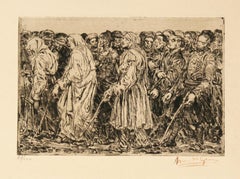
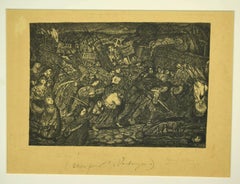
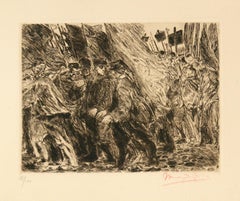
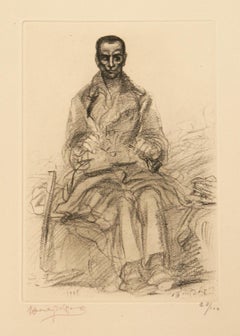
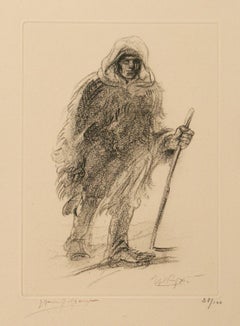
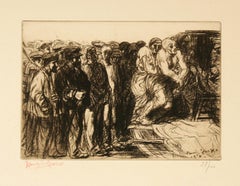

![carriere painter Le Fondeur Paris [Steel Worker]](https://a.1stdibscdn.com/eugene-carriere-prints-works-on-paper-le-fondeur-paris-steel-worker-for-sale/a_2922/1610896410669/Carriere_E_master.jpg?width=240)

